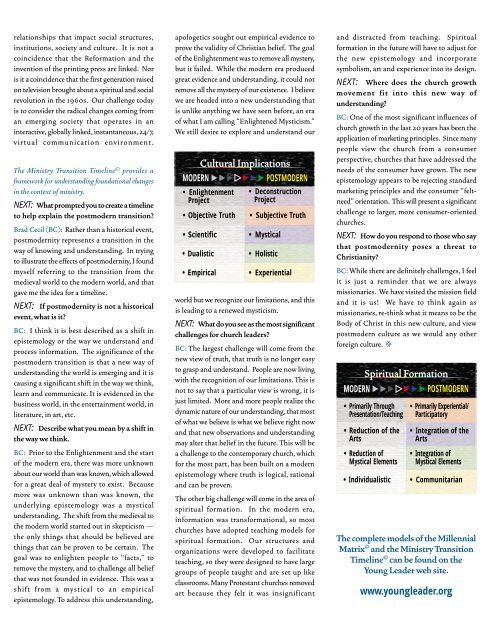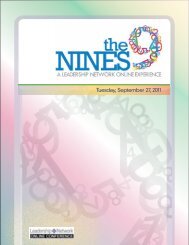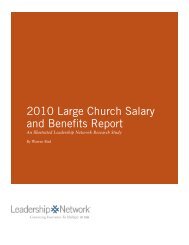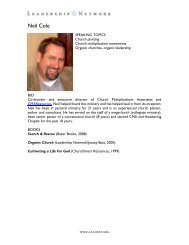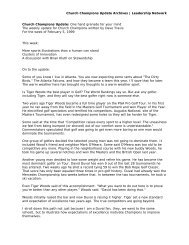ARE WE A PEOPLE AT HALF TIME? - Leadership Network
ARE WE A PEOPLE AT HALF TIME? - Leadership Network
ARE WE A PEOPLE AT HALF TIME? - Leadership Network
Create successful ePaper yourself
Turn your PDF publications into a flip-book with our unique Google optimized e-Paper software.
elationships that impact social structures,<br />
institutions, society and culture. It is not a<br />
coincidence that the Reformation and the<br />
invention of the printing press are linked. Nor<br />
is it a coincidence that the first generation raised<br />
on television brought about a spiritual and social<br />
revolution in the 1960s. Our challenge today<br />
is to consider the radical changes coming from<br />
an emerging society that operates in an<br />
interactive, globally linked, instantaneous, 24/7,<br />
virtual communication environment.<br />
The Ministry Transition Timeline © provides a<br />
framework for understanding foundational changes<br />
in the context of ministry.<br />
NEXT: What prompted you to create a timeline<br />
to help explain the postmodern transition<br />
Brad Cecil (BC): Rather than a historical event,<br />
postmodernity represents a transition in the<br />
way of knowing and understanding. In trying<br />
to illustrate the effects of postmodernity, I found<br />
myself referring to the transition from the<br />
medieval world to the modern world, and that<br />
gave me the idea for a timeline.<br />
NEXT: If postmodernity is not a historical<br />
event, what is it<br />
BC: I think it is best described as a shift in<br />
epistemology or the way we understand and<br />
process information. The significance of the<br />
postmodern transition is that a new way of<br />
understanding the world is emerging and it is<br />
causing a significant shift in the way we think,<br />
learn and communicate. It is evidenced in the<br />
business world, in the entertainment world, in<br />
literature, in art, etc.<br />
NEXT: Describe what you mean by a shift in<br />
the way we think.<br />
BC: Prior to the Enlightenment and the start<br />
of the modern era, there was more unknown<br />
about our world than was known, which allowed<br />
for a great deal of mystery to exist. Because<br />
more was unknown than was known, the<br />
underlying epistemology was a mystical<br />
understanding. The shift from the medieval to<br />
the modern world started out in skepticism —<br />
the only things that should be believed are<br />
things that can be proven to be certain. The<br />
goal was to enlighten people to “facts," to<br />
remove the mystery, and to challenge all belief<br />
that was not founded in evidence. This was a<br />
shift from a mystical to an empirical<br />
epistemology. To address this understanding,<br />
apologetics sought out empirical evidence to<br />
prove the validity of Christian belief. The goal<br />
of the Enlightenment was to remove all mystery,<br />
but it failed. While the modern era produced<br />
great evidence and understanding, it could not<br />
remove all the mystery of our existence. I believe<br />
we are headed into a new understanding that<br />
is unlike anything we have seen before, an era<br />
of what I am calling “Enlightened Mysticism.”<br />
We still desire to explore and understand our<br />
MODERN<br />
• Enlightenment<br />
Project<br />
• Objective Truth<br />
• Scientific<br />
• Dualistic<br />
• Empirical<br />
Cultural Implications<br />
• Holistic<br />
POSTMODERN<br />
• Deconstruction<br />
Project<br />
• Subjective Truth<br />
• Mystical<br />
• Experiential<br />
world but we recognize our limitations, and this<br />
is leading to a renewed mysticism.<br />
NEXT: What do you see as the most significant<br />
challenges for church leaders<br />
BC: The largest challenge will come from the<br />
new view of truth, that truth is no longer easy<br />
to grasp and understand. People are now living<br />
with the recognition of our limitations. This is<br />
not to say that a particular view is wrong, it is<br />
just limited. More and more people realize the<br />
dynamic nature of our understanding, that most<br />
of what we believe is what we believe right now<br />
and that new observations and understanding<br />
may alter that belief in the future. This will be<br />
a challenge to the contemporary church, which<br />
for the most part, has been built on a modern<br />
epistemology where truth is logical, rational<br />
and can be proven.<br />
The other big challenge will come in the area of<br />
spiritual formation. In the modern era,<br />
information was transformational, so most<br />
churches have adopted teaching models for<br />
spiritual formation. Our structures and<br />
organizations were developed to facilitate<br />
teaching, so they were designed to have large<br />
groups of people taught and are set up like<br />
classrooms. Many Protestant churches removed<br />
art because they felt it was insignificant<br />
and distracted from teaching. Spiritual<br />
formation in the future will have to adjust for<br />
the new epistemology and incorporate<br />
symbolism, art and experience into its design.<br />
NEXT: Where does the church growth<br />
movement fit into this new way of<br />
understanding<br />
BC: One of the most significant influences of<br />
church growth in the last 20 years has been the<br />
application of marketing principles. Since many<br />
people view the church from a consumer<br />
perspective, churches that have addressed the<br />
needs of the consumer have grown. The new<br />
epistemology appears to be rejecting standard<br />
marketing principles and the consumer “feltneed"<br />
orientation. This will present a significant<br />
challenge to larger, more consumer-oriented<br />
churches.<br />
NEXT: How do you respond to those who say<br />
that postmodernity poses a threat to<br />
Christianity<br />
BC: While there are definitely challenges, I feel<br />
it is just a reminder that we are always<br />
missionaries. We have visited the mission field<br />
and it is us! We have to think again as<br />
missionaries, re-think what it means to be the<br />
Body of Christ in this new culture, and view<br />
postmodern culture as we would any other<br />
foreign culture.<br />
MODERN<br />
Spiritual Formation<br />
• Primarily Through<br />
Presentation/Teaching<br />
• Reduction of the<br />
Arts<br />
• Reduction of<br />
Mystical Elements<br />
• Individualistic<br />
POSTMODERN<br />
• Primarily Experiential/<br />
Participatory<br />
• Integration of the<br />
Arts<br />
• Integration of<br />
Mystical Elements<br />
• Communitarian<br />
The complete models of the Millennial<br />
Matrix © and the Ministry Transition<br />
Timeline © can be found on the<br />
Young Leader web site.<br />
www.youngleader.org


